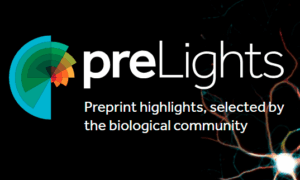By Jordan F. Sampar and Lilian N. Calò
The opening scene of Stanley Kubrick’s well-known 1968 film 2001: A Space Odyssey shows a prehistoric man exploring the bones of a dead animal, already completely decomposed. The first man feels the skeleton of the second and… there is a new discovery! A bone is found, and, from it, a secondary function is designated, in addition to the biological one.
Although there is subjectivity of meaning, the scene from 2001 clearly demonstrates the reception of new information, contact with previously unknown content, the identification of its properties, the path taken to that discovery, the evaluation of what is done based on these new findings, and also the designation of a new function.
We could continue to describe the scene from Kubrick’s anthological film, but it is also possible to draw parallels between the 1968 film and the present day, especially when we think about the production and dissemination of preprints for the academic community.
Preprints are manuscripts deposited in open access in a repository or preprint server prior to peer review. Authors use this resource before submitting their manuscript to a journal or simultaneously with submission, so that the results can be immediately shared with the scientific community. Preprints can be cited (they have a DOI) and, despite not being reviewed before publication, they can receive comments, which function as post-publication peer review.
In most cases, authors consider these comments when making changes to the manuscript and finally submitting it to a journal and the traditional peer review process. Estimates show that 70% of preprints on bioRxiv, a preprint server for biological sciences, are published in journals within two years of their initial posting on the server, and 38% of these preprints receive at least one comment.
As the production of preprints increases and considering their relevance and interest in the scientific community, the demand to identify and select potential reviewers to comment on preprints becomes more relevant. In this sense, The Company of Biologists, in partnership with the biological sciences community, established a platform in 2018 formed by young researchers to evaluate preprints. This was the genesis of preLights.
The team of scientists (called “preLighters”) consists of doctoral students (48%), postdocs (46%), and principal investigators (PIs) and/or others (6%). Their mission is to select, highlight, and comment on preprints that are particularly interesting to them and that have an impact on the biological community. Most preprints are selected from platforms such as bioRxiv, following the criterion of a maximum of three months after publication.
Once extracted, the preprint is commented on by the researcher in an authorial publication on a website hosted by The Company of Biologists. In their publication, the preLighter author summarizes the chosen preprint, lists the highlights of the results, their contribution to their (or their group’s) line of research, and puts it up for questions to the original authors, which can be answered in the comments and later linked to the preprint publication on the preLights website.
The preLights preprint server is a community initiative supported by The Company of Biologists, a non-profit publisher dedicated to supporting and inspiring the biological sciences community. This community carries out its activities through publications, events, and postgraduate scholarships, in addition to offering additional support to the community by promoting scientific meetings, providing scholarships for researchers to participate in events, and supporting scientific societies.
The company is run by renowned and active scientists, and profits are returned to science rather than to shareholders. In this way, the publisher inspires new ideas and supports the biology community. In addition, The Company of Biologists publishes five specialized, peer-reviewed journals: Development, Journal of Cell Science, Journal of Experimental Biology, Disease Models & Mechanisms, and Biology Open.
Among the advantages of being part of the team is the encouragement of new scientific thinking and methodological approaches that can be applied to the research developed by preLights, as well as bringing together researchers from the community and authors of preprints, promoting scientific collaboration between research groups, wide dissemination on social networks, and the dialogue that is key to continuing to underpin the importance of peer review.
In Kubrick’s film, prehistoric man strikes the bone—his new discovery—against the animal’s skeleton until it is destroyed, reducing it to fragments. Similar is the refinement of a preprint for the validation of a new discovery and/or contribution to a particular area. In a kind of celebration and demarcation of temporal evolution, man throws the bone up, which spins, and the scene cuts to a space satellite. In contemporary times, the union of efforts manages to understand, describe, and raise questions about different areas so that, through dialogue, we too can get there.
External links
2001: A Space Odyssey – Wikipedia
About Jordan F. Sampar
Jordan F. Sampar holds a bachelor’s degree in biomedical sciences and a master’s degree in Neurophysiology from the Faculdade de Medicina de Ribeirão Preto (FMRP) at the Universidade de São Paulo (USP). He is currently a doctoral student at the Universidade Estadual de Campinas (Unicamp). He has expertise in the areas of Developmental Biology, Embryology, Neurophysiology, and Neurodevelopment. He has also published two books and is actively involved in the interface between science, education, data, and society.
About Lilian Nassi-Calò
Lilian Nassi-Calò studied chemistry at Instituto de Química – USP, holds a doctorate in Biochemistry by the same institution and a post-doctorate as an Alexander von Humboldt fellow in Wuerzburg, Germany. After her studies, she was a professor and researcher at IQ-USP. She also worked as an industrial chemist and presently she is Coordinator of Scientific Communication at BIREME/PAHO/WHO and a collaborator of SciELO.
Translated from the original in Portuguese by Lilian Nassi-Calò
Como citar este post [ISO 690/2010]:






![Funders support use of reviewed preprints in research assessment [Originally published by eLife in December/2022] eLife logo](https://blog.scielo.org/en/wp-content/uploads/sites/2/2022/11/eLife-logo_thumb.jpg)

![Lack of sustainability plans for preprint services risks their potential to improve science [Originally published in the LSE Impact blog in March/2023] Fotografia de um servidor de rede.](https://blog.scielo.org/en/wp-content/uploads/sites/2/2023/03/taylor-vick-M5tzZtFCOfs-unsplash_thumb.jpg)









Recent Comments